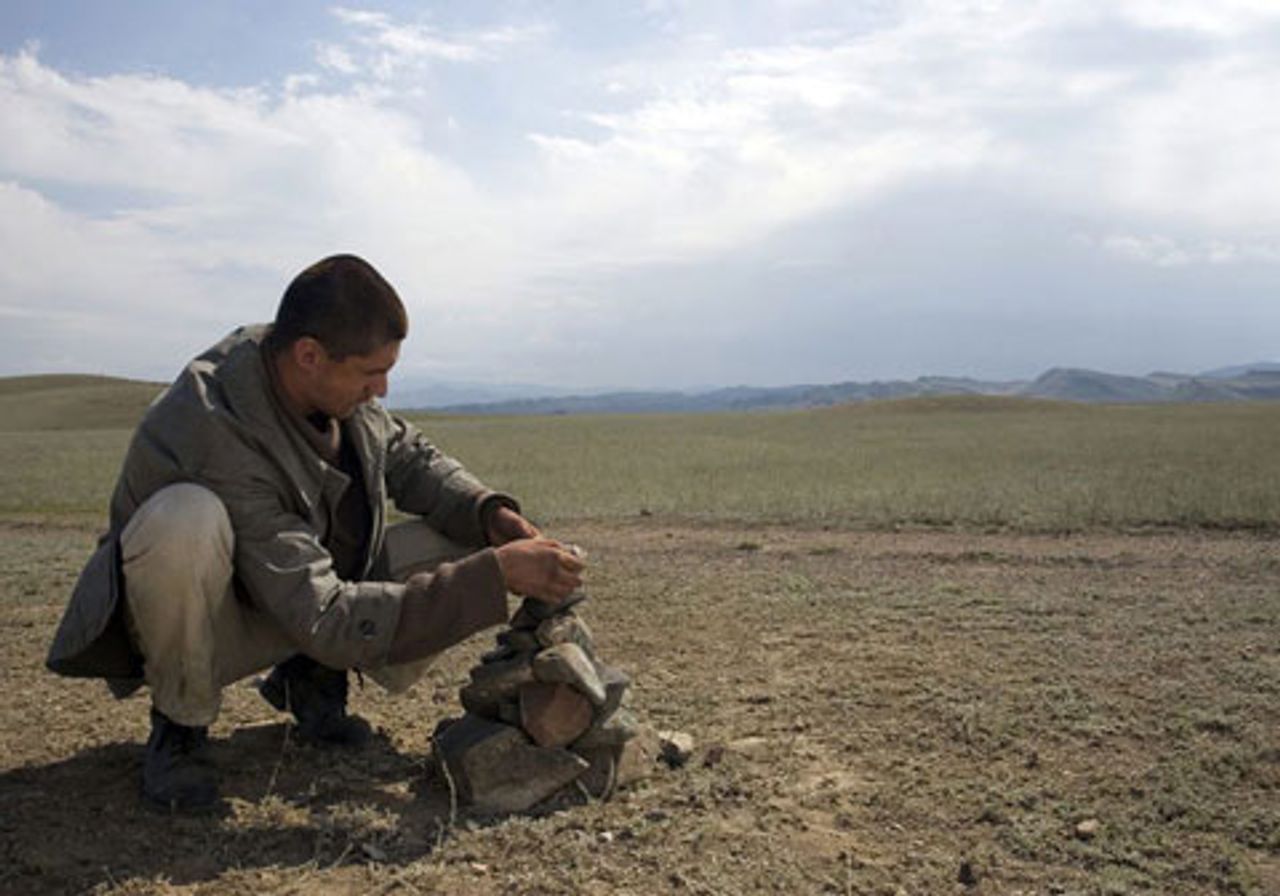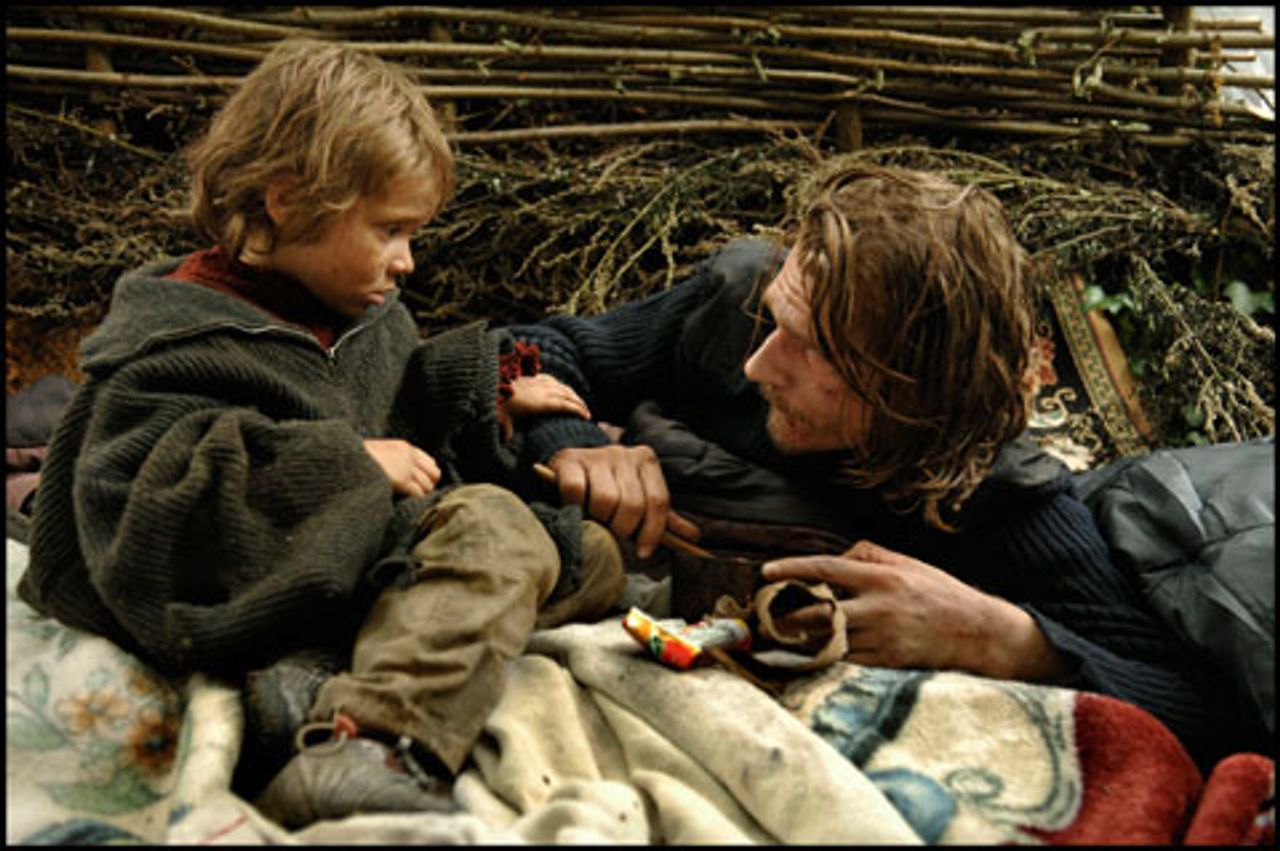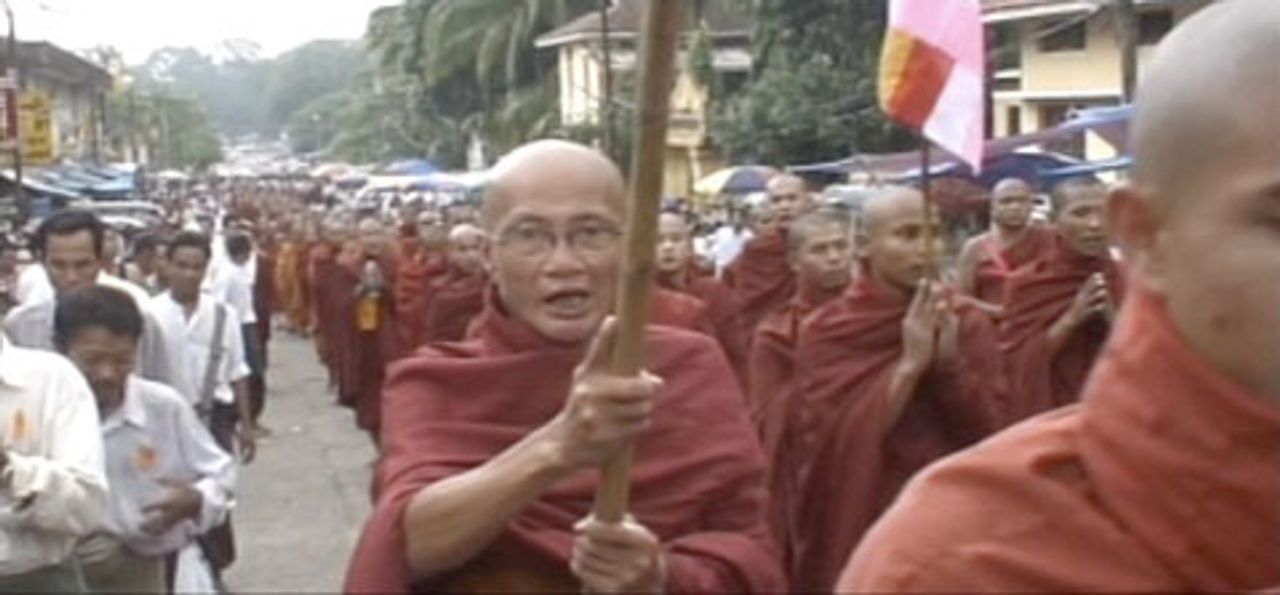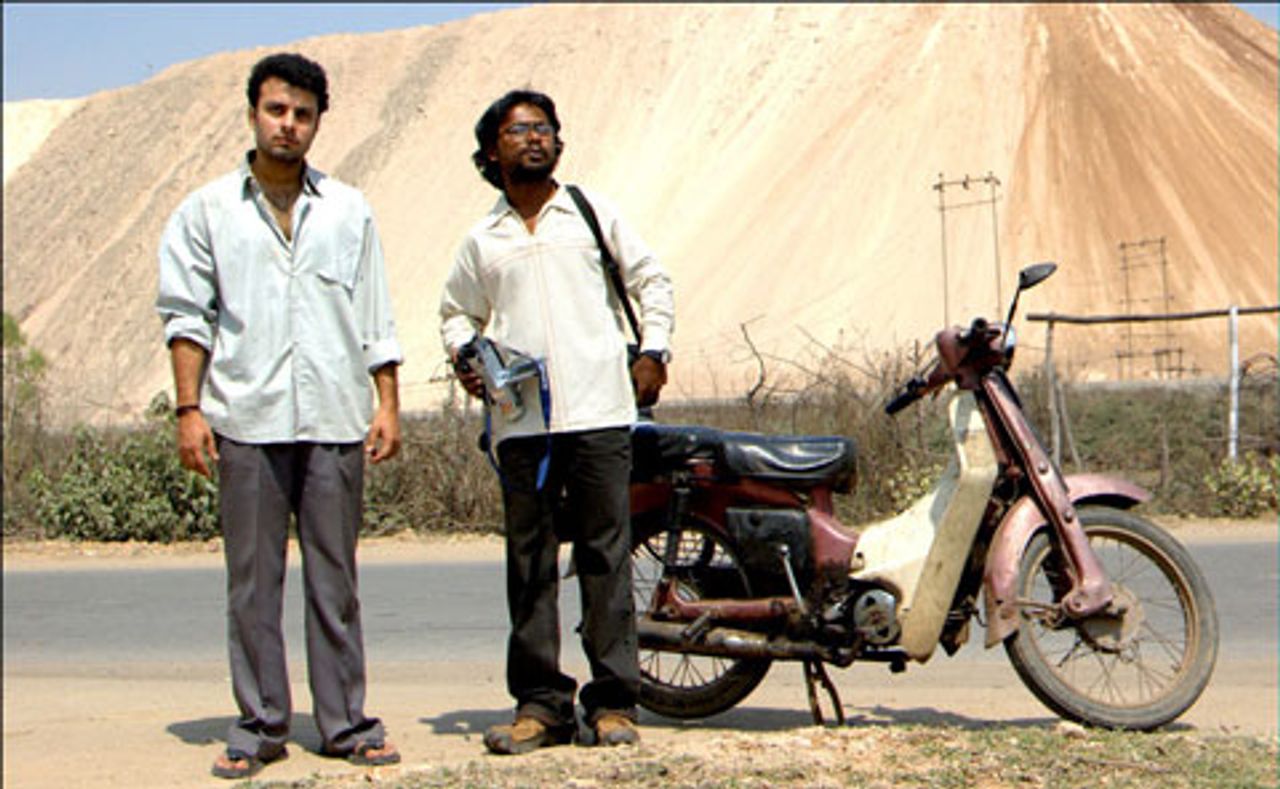This is the fourth of a series of articles on the 2009 San Francisco International Film Festival, held April 23-May 7. Part 1 was posted May 20; Part 2 was posted May 22. Part 3 was posted May 25.
Wild Field (Dikoe Pole)
The Russian film industry virtually collapsed in the years following the disintegration of the Soviet Union in 1991, with fewer than 50 films made a year by 1995. Although there has been a rebound, with more than 200 Russian films in production in 2008, most are of questionable value.
 Wild Field
Wild FieldIt is interesting, therefore, that within this slim output, two of the films that have received international accolade, Tulpan and Wild Field, are both about the Kazakh steppes.
In a recent interview with the WSWS, Tulpan’s director Sergey Dvortsevoy said that the challenge of filming a story in this stark region is to “create energy almost out of nothing and show that if you look more carefully at this landscape you begin to understand that it’s full of life, relationships and great beauty.... Since the collapse of the Soviet Union it has become very difficult for these people. There were subsidies, but these have gone, and life has become much harder. It’s a very tough life and they depend entirely on the weather.”
The resurgence of the most elemental conditions of life in the Kazakh steppes speaks to the dimensions of the nightmare engulfing the territories of the former USSR.
Wild Field is directed by Georgian-born Russian filmmaker Mikhail Kalatozishvili, the grandson of Mikhail Kalatozov, the only Russian director to have received the Palme d’Or at Cannes.
The film focuses on Mitya (Oleg Dolin), a young doctor in a remote medical outpost who deals with all the difficulties of the steppes’ people. In a landscape of dust and more dust, horses are the primary mode of transportation, and a grizzled policeman (Roman Madyanov) is the only authority. The primitiveness of the circumstances suggests a long-gone era, but a news broadcast establishes the date as August 2007.
Mitya ministers, with equal concern, to an older man whose heart stopped beating after a 40-day drinking binge and a cow that’s eaten a tablecloth.
“The worse life is, the less people fall ill” is the general line of reasoning, but there is unrelenting poverty and soon there will be “no gas, no coal or no money.”
A senior medical doctor (Yuri Stepanov) arrives, angry and cynical about the state of affairs. There are no medical supplies to deliver and “soon there will be no money” to pay Mitya.
He complains explosively that there “used to be a hospital here with an airplane parked behind it—they have destroyed it all. I don’t believe in God, but when He comes I’ll ask Him, has He turned His back on Russia or not. If He has, then why didn’t He kill all of us at once? Why did He leave us just as we are?” He throws Mitya a pitifully small package—“American humanitarian aid”!
Mitya’s fiancée shows up. Until this point, the audience has more or less been led to believe that the photo on his desk and the letter he is on constant look-out for were perhaps imaginary. But she is real and so is their love. They spend a few blissful days together. One morning, however, apparently out of the blue, she packs up, whispering, “I’m leaving and going far away. I just came to say goodbye. I’ve married another man. There’s nothing we can do about it. I’ll never see you again.” Pretending to be asleep, he lets her go.
Mitya’s heroic devotion to the population, his creativity and resourcefulness are on particular display when he treats a young girl stabbed by her boyfriend who has also wounded himself. An outdoor stone slab made antiseptic by the wind is the operating theater. The veins of a sheep slain for the emergency provide the sutures. Expertise, and also tenderness, come into play.
Now and again, a mysterious silhouetted man, perhaps a ghost of the steppes, lurks on the horizon. “A guardian angel,” muses Mitya. It turns out to be a man so ravaged (and blackened) by neglect and poverty that he can’t bear to be touched by the doctor. Catching Mitya off-guard, the strange man sticks him with a syringe—for no obvious reason, except his own pain and misery—and flees, leaving the physician on death’s door.
The locals tend to him. “Dmitry Vasilyevich, don’t die, we can’t get by without you,” is the general cry.
Wild Field is an appreciation of those who choose to stay and try to plug the holes in a bursting dike. Herein lies the film’s strength, and its Achilles heel. In an interview reproduced in the production notes, director Kalatozishvili insists that “only individuals are important to me,” whatever that may mean. The vast intellectual damage wrought by Stalinism, with its state-imposed “Marxism” and its “Socialist Realism,” continues to weigh on Russian artists.
The fact that the filmmaker seems so determined that his work not be seen as a social critique is problematic. In spite of himself, however, Kalatozishvili has introduced certain concrete details that undermine this misguided effort. The appearance of the medical supervisor saves the film and puts everything that has gone before and comes after it in a definite historical context.
The director’s pessimism conflicts with his humane impulses. He believes, inevitably, that social change is impossible. Or as he puts it, “It’s a story where time is frozen, a story that will exist for ever,” which is a dreadful thought.
Further, the presentation of many of the local people seems a meditation on the eternally eccentric Russian personality. In one scene, science is trumped by folk wisdom when a man comes back to life after being struck by lightning.
Mitya, however, is a complex and authentic character. Overall, the film has numerous beautiful and concrete moments.
Versailles
According to French director Pierre Schoeller, there are some 900,000 people in France who live in “makeshift shelters, huts, tents, caravans, garages, plastic greenhouses.... And even in Versailles, in the grounds of the palace, a few outsiders have found refuge in the woods.” This, he describes as a “state of latent decomposition.”
 Versailles
VersaillesIn Schoeller’s movie, 23-year-old Nina (Judith Chemia) and her five-year-old son Enzo (Max Baissette de Malglaive) are homeless in Paris. During the cold nights, they scurry in and out of dark alleys to find shelter, until patrolling social workers offer the pair warm food and a bed. Nina is wary of the authorities for fear of losing her child. Plus, she is tired of the bureaucratic runaround. They end up in Versailles where they stumble across Damien (Guillaume Depardieu, in his last movie before his sad death last October). A recovering drug addict and ex-convict, he lives in the woods with other outcasts and drop-outs.
Nina feels free and at ease for the moment, but suddenly disappears, leaving Enzo with Damien. Despite a rocky beginning, the pair develop an attachment. To provide Enzo with a modicum of stability, Damien finds himself willing to reconcile with his disapproving father and take a backbreaking job. Unfortunately, the effort proves to be too much, and Enzo, now twice abandoned, ends up living unhappily with Damien’s father and stepmother—until Nina reenters the picture.
About Versailles, says director Schoeller, the “problem was to tackle poverty while avoiding gloom and powering the film with a fine energy.” The question, however, is not avoiding gloom, but presenting the situation truthfully. Myriad plot contortions replace dealing directly with what is. To his credit, Schoeller attempts to reference social issues—fairly untypical for current French cinema. Unfortunately, he is bent on belaboring, rather amateurishly, questions like “the power of bonds” and the psychology of those like Damien who affirm “life force, strength and health,” and Nina who have “never been considered or esteemed.”
The movie is not striking or successful as an attempt to contrast the pomp of the palace of Versailles and the wretched living conditions of the interlopers on its grounds. It substitutes murky psychologism for a concrete and serious encounter with modern French life, which includes, by the way, mass protests and strikes on a regular basis.
Burma VJ: Reporting From A Closed Country
In September 2007, demonstrations involving tens of thousands of people broke out in Burma. Initially prompted by the military dictatorship’s imposition of intolerable price increases, the revolt broadened as anger rose toward the junta’s repressive rule, its privileged existence and the deterioration of living standards.
 Burma VJ: Reporting From A Closed Country
Burma VJ: Reporting From A Closed CountryDemonstrators also demanded the release from house arrest of opposition leader Aung San Suu Kyi of the National League of Democracy. (Suu Kyi is currently being tried at a prison in Rangoon on charges that she violated the terms of her incarceration.)
Burma VJ, directed by Danish filmmaker Anders Østergaard, is largely comprised of material shot by undercover correspondents during the September 2007 events. The footage was then smuggled out of the country via Internet or courier and broadcast from Oslo, Norway, back into Burma. Some of the reporters were apprehended by the regime’s secret police.
Despite the courage of the video journalists in obtaining the raw footage, the film’s liberal politics are damaging. Never venturing beyond the headlines, movies like Burma VJ point the finger at repressive governments, but never dig into the machinations of the major powers and the more profound social processes at work.
It is quite disturbing, for example, that former President George W. Bush is given a forum to speak, merely because at the time he made a few mild criticisms of the junta and threatened sanctions. Washington’s concern was not for the people of Burma, but for American interests: in particular the US oil giant Chevron, which took over from Unocal as the main partner of France’s Total in the development of Burma’s Yadana gas field.
(Ai-Tsao) Artemisia
Taiwanese director Chiang Hsiu-chiung began her career working as assistant director to Taiwanese New Wave filmmakers Hsiao-Hsien Hou and Edward Yang. In her movie Artemisia, Ai-tsao (Pan Li Li) is a middle-aged woman who attends to her narrow-minded, parsimonious mother, while her closeted gay son fears coming out to her. When her daughter returns home from studying abroad as an unwed mother, Ai-tsao is forced to confront her own intolerance.
The film is well made and its characters decently drawn. But it is a slight family drama that sounds a predictable, familiar note and never ventures outside of conventional territory. It is a further indication that the Taiwanese New Wave has crashed and dissipated.
Mohandas and Sonbahar (Autumn)
Indian filmmaker Mazhar Kamran uses the metaphor of identity theft to represent India 60 years after the 1948 murder of Mohandas Gandhi in his film Mohandas. In New Delhi, a television reporter investigates the case in central India of Mohan Das, a talented young man who is stripped of his identity and dignity by a conniving, corrupt classmate, whose gross misdeed is backed by the authorities. The movie indicts a society in which “thugs, bandits and criminals have all reached up to the apex of our democratic institutions. This is not democracy. This is plutocracy. Those who are rich, they form the government. They rule.”
 Mohandas
MohandasDespite its anger and acknowledgement in a postscript of those who have fought the system, Mohandas’s lamentation about Gandhi’s lost legacy makes for weak artistic and political results.
In Turkish director Özcan Alper’s film Autumn, Yusuf (Onur Saylak)—released in 1997 after 10 years as a political prisoner—finds life hard when he returns to his remote mountain village near the Black Sea. Says Alper, “The dissolution of the USSR and the beginnings of globalization had an enormous influence on us, as we were trying to find our place in the struggle against the anti-democratic laws introduced by the victors of the 1980 coup d’état. Thousands of left-wing students were jailed as political prisoners for having demanded greater freedom.”
Like his main character, Alper does not understand either the content of the USSR’s “socialism,” nor the reasons for its demise. The transition from autumn to winter epitomizes the film’s bleak outlook, best expressed by Yusuf’s friend Mikhail: “At least in the old days, there was hope of life under socialism [in the USSR], however right or wrong. Now they’ve taken that away too. Now their [Russian] women come to work as whores, and the men nick the steel from the factories to sell.”
Confessional and La Buena Vida
An incoherent mockumentary, Filipino filmmaker Ruel Dahis Antipuesto’s Confessional makes no serious attempt to grapple with the current state of affairs in the Philippines. The film treats in an off-beat manner a school collapse in which many children were killed and the corrupt building practices that were to blame. This is Antipuesto’s first film, and I hope he’ll take a sharper look at the world and use his penchant for irony to better effect.
In Chilean director Andrés Wood’s The Good Life:a hairdresser applies for financing to buy a car while unresolved family matters overwhelm him; a social worker teaches prostitutes about safe sex as her neglected teenage daughter becomes pregnant; a young clarinetist, thwarted in his ambition to join the philharmonic orchestra, enlists in the army to play in a police military band.
In terms of plot, the three stories only tangentially intersect, but the rather vapid moralizing is uniform throughout. Moreover, given Chile’s history, it is astonishing that the film does not have a problem with the military.
To be continued
